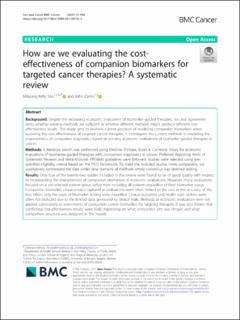| dc.contributor.author | Seo, Mikyung Kelly | |
| dc.contributor.author | Cairns, John Alexander | |
| dc.date.accessioned | 2022-04-08T11:44:19Z | |
| dc.date.available | 2022-04-08T11:44:19Z | |
| dc.date.created | 2021-09-15T13:59:05Z | |
| dc.date.issued | 2021 | |
| dc.identifier.issn | 1471-2407 | |
| dc.identifier.uri | https://hdl.handle.net/11250/2990763 | |
| dc.description.abstract | Background
Despite the increasing economic assessment of biomarker-guided therapies, no clear agreement exists whether existing methods are sufficient or whether different methods might produce different cost-effectiveness results. This study aims to examine current practices of modeling companion biomarkers when assessing the cost-effectiveness of targeted cancer therapies. It investigates the current methods in modeling the characteristics of companion diagnostics based on existing economic evaluations of biomarker-guided therapies in cancer.
Methods
A literature search was performed using Medline, Embase, EconLit, Cochrane library for economic evaluations of biomarker-guided therapies with companion diagnostics in cancer. Preferred Reporting Items of Systematic Reviews and Meta-Analyses (PRISMA) guidelines were followed. Studies were selected using pre-specified eligibility criteria based on the PICO framework. To make the included studies more comparable, we qualitatively synthesized the data under nine domains of methods where consensus was deemed lacking.
Results
Only four of the twenty-two studies included in this review were found to be of good quality with respect to incorporating the characteristics of companion biomarkers in economic evaluations. However, many evaluations focused on a pre-selected patient group rather than including all patients regardless of their biomarker status. Companion biomarker characteristics captured in evaluations were often limited to the cost or the accuracy of the test. Often, only the costs of biomarker testing were modelled. Clinical outcomes and health state utilities were often not included due to the limited data generated by clinical trials. Methods of economic evaluation were not applied consistently in assessments of companion cancer biomarkers for targeted therapies. It was also shown that conflicting cost-effectiveness results were likely depending on what comparator arm was chosen and what comparison structure was designed in the model.
Conclusion
We found no consistent approach applied in assessing the value of companion biomarker tests and including the characteristics of biomarkers in an economic evaluation of targeted oncology therapies. Currently, many economic evaluations fail to capture the full value of companion biomarkers beyond sensitivity/specificity and cost related to biomarker testing. | en_US |
| dc.language.iso | eng | en_US |
| dc.publisher | BioMed Central | en_US |
| dc.rights | Navngivelse 4.0 Internasjonal | * |
| dc.rights.uri | http://creativecommons.org/licenses/by/4.0/deed.no | * |
| dc.title | How are we evaluating the cost-effectiveness of companion biomarkers for targeted cancer therapies? A systematic review | en_US |
| dc.type | Journal article | en_US |
| dc.type | Peer reviewed | en_US |
| dc.description.version | publishedVersion | en_US |
| dc.rights.holder | Copyright 2021 The Author(s) | en_US |
| dc.source.articlenumber | 980 | en_US |
| cristin.ispublished | true | |
| cristin.fulltext | original | |
| cristin.qualitycode | 1 | |
| dc.identifier.doi | 10.1186/s12885-021-08725-4 | |
| dc.identifier.cristin | 1934581 | |
| dc.source.journal | BMC Cancer | en_US |
| dc.identifier.citation | BMC Cancer. 2021, 21, 980. | en_US |
| dc.source.volume | 21 | en_US |

